Animalistiary #5; The Dragons
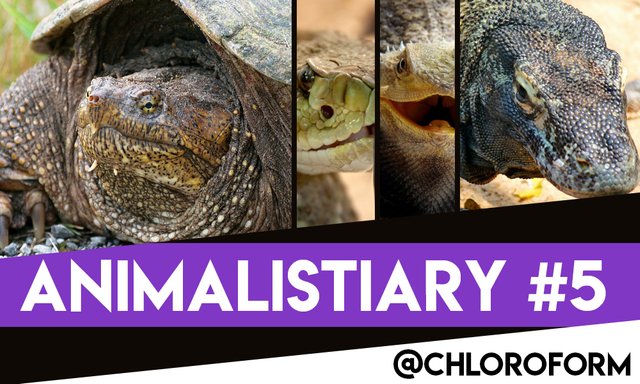
Well, to be fair, the title is a little bit misleading. In this episode of Animalistiary I would introduce to you some of the animals which either dragon-like, have some attributes similar to dragons or might behave somewhat similar to the mythical creature. Just like I've said in my previous article, I'm really fascinated by the idea of having dragons in our world although the implications of it were frowned upon. If we were to imagine they were real, they might be one of the most dangerous apex predators in the whole wide world. Sure, there have always been stories about dragon hunters, someone who was skilful enough to possibly, single-handedly bring down a dragon to its knee, but not everyone would have that kind of strength and dexterity to compete with a creature which can fly, breath out fire and have an average size of the smallest mountain.
Well, let's leave all of the things related to the mythical dragon for now and let's scour the earth for any creatures which are worthy to be called as the dragon (or at least their descendant).
The Dragon Snake
Although this snake is quite rare and possibly small in number, the International Union for Conservation of Nature (IUCN) red list has listed them as one of the animals under the category of least concern. They were usually found in South East Asia particularly in Myanmar, Indonesia and Thailand. One of the possible reasons why this creature was so rare can be due to the fact that they were not prolific breeders. That means, instead of laying lots of eggs (possibly more than anyone can count), a dragon snake will only lay an average of 2-4 eggs in a year. There were few pieces of information that can be extracted regarding this creature as they were rarely found and usually were difficult to be kept alive in captivity.
The most interesting thing about this snake is, its skin wasn't really smooth like any other snakes which are quite slippery when they were held. That's why this species of snake was called Xenodermus javanicus; Xenodermus literally meant strange skin. The skin was made up of scales which are arranged in three separate rows, resembling a dragon's tail. They can grow up to 30 inches in length (yeah, it's quite small) with a prominent head. They were nocturnal hunters, seeking for their prey amidst the dark of the night and wandering the underground during the day making it difficult for predators to hunt them. They can be commonly found in the area which is close to a river or basically anywhere which were moist with an abundant amount of water like the paddy field, marshes and swamps.
Unlike any other species of snakes, they have a really strange habit of becoming stiff like a long twig instead of loosening themselves, attempting to escape when they were picked up or touched by something which they perceived as threatening. So far they were known to prey on frogs and fishes which can be found easily while strolling around at night and possibly while swimming in the river or any water sources near the paddy field. Their existence in the paddy field area proved that they weren't even struggling with human activities which might have affected affect their original natural habitat, possibly a forest and any habitat related to it (swamps). However, they were currently threatened by the use of pesticides and chemical fertilisers especially when all of the substances affect the population of its natural prey which is frogs and fishes.
The Pogona
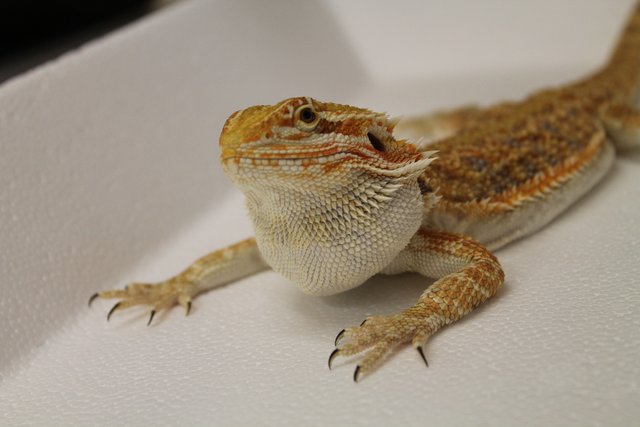
This is one of the most popular pet animals in the world. The Pogona also known as the bearded dragon is one of the most interesting lizards which can be found, inhabiting some rocky regions, located in Australia. They can grow up to 25 inches, were flexible, extremely tame but not quite intelligent. Due to its small or moderate (depending on the people who perceived it) size, they were relatively easy to be kept as a pet and sometimes, quite entertaining, especially when they were hunting for foods. They were omnivorous, eating both plants and insects but most of their diet constitute of the latter. They were proficient climbers and can usually be seen, hanging around on branches, hiding in the bushes to cool themselves during the hot day and sometimes, basking for pleasure. If you realised, from the picture, there were a lot of spiny, thorn-looking projections on its skin, most prominent on its mandibular area which resembles a beard (thus the name).
However, the structures were not sharp, they were quite flexible and soft if you felt like caressing those things. Cares should be taken as the beardy area can grow twice the size and darken when they felt threaten or trying to court a female bearded dragon. They were extremely territorial and that's why it's not a good idea to be keeping two of those creatures inside the same cage. They might attack each other and if they were of the opposite gender, a male can attack a female if the latter doesn't show an act of submission which is usually represented in the form of an arm waving. Quite interesting isn't it? A female bearded dragon would be able to raise up its front leg and waves in the air as a sign of submission to a specific male. When the beardy area became dark and swollen to twice its normal size while retaining its defensive stance, they do appear like a dragon (they don't breathe fire, though).

Unlike most of the animals, the reproductive ritual of the bearded dragon can be seen as a figurative "raping" instead of the female willingly submitting themselves to be copulated by the male. When a male bearded dragon wants to mate, it will find a desirable female, signalling them by hand waving, ground stomping and head bobbing which will usually make the female to run. The male will then chase the prospective female, bite the back of their neck to minimise its mobility and while depositing some sperm inside a storage area held by the female which is called as the oviductal crypts. After a brief period of fertilisation, they would be able to lay 20-30 eggs, two times; which means, a single reproduction can produce up to 60 eggs.
The sex of the hatchling would be heavily determined by the surrounding temperature, making it easy for us (humans) to predict the gender of the hatchling; if the eggs were harboured in the surrounding temperature of 34 degrees Celcius or higher, the hatchling would be female and vice versa. This is one of the reasons why they were considered popular exotic pets in the first place. You will be able to produce a great number of hatchling, with a predetermined sex, although a great number of them were exposed to congenital defect if proper cares were not provided.
The Dragon Millipede
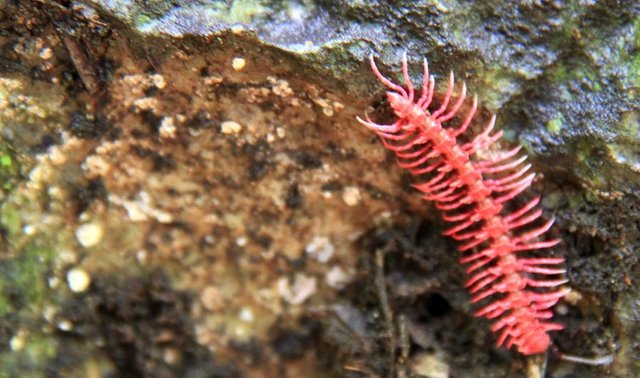
Like the first two dragons, dragon millipedes have some spiky structures which were arranged in two rows along their lengthy bodies, usually pink to almost transparent coloured which make them looks intimidating. They were usually found in Thailand, Malaysia, Myanmar and China and currently, 33 species have been discovered although most of them were found in caves located in China (they were called as the Chinese dragon millipedes). If you remember, a couple of months back, I've written a fact regarding the colour of an animal sometimes can indicate they were poisonous. Well, dragon millipedes were extremely poisonous indicated by their bright body discolouration. I mean, if some predators die due to the fact that they were poisoned by this millipede, tough luck, you have been warned.
They were usually red or a lighter variation of the red colour (pink maybe?) which clearly indicates they weren't suitable for consumption. If we want to compare this animal with dragons, then the most probable similarity that both of them had is they can breath out something from a specific gland to protect themselves from danger; it just that, a typical dragon would have breath fire while a typical dragon millipede will breath out poison in the form of hydrogen cyanide. You know about cyanide right? It can cause a variety of symptoms in humans, provided it is ingested or inhaled in a lethal dose. The symptoms include the standard variation of gastrointestinal upset symptoms (nausea, vomiting, abdominal pain), rapid breathing (tachypnoea), severe headache, hypotension and loss of consciousness (fainting).
There were no known species of animals which were immune to the hydrogen cyanide which is secreted by this dragon thus they have no known natural predator which is capable of feasting on their poisonous bodies. Even though they look pretty solid, they were extremely delicate; even the slightest touch can trigger the hydrogen cyanide to be secreted. Most of the animals which shared the same natural habitat with this particular creature can be killed if they accidentally touch it (dragon millipedes have an impressive camouflaging capability). They emit an almond-like smell which results from the hydrogen cyanide they were producing. Even though a lot of information has been discovered pertaining to this dragon itself, there are a lot of things we still don't know about this creature.
The Komodo Dragon
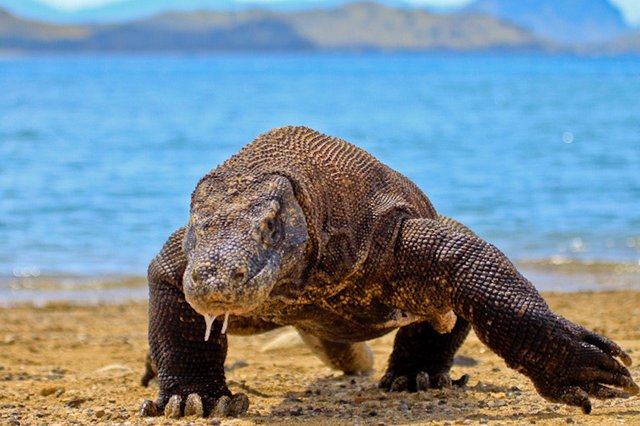
When we were talking about the dragon, Komodo dragon is one of my favourite animals which seems dragon-related. They were considered as the largest lizard ever walked on earth and mostly can be found on various islands, in Indonesia. Originally, other than Indonesia, Komodo dragons can be found in Australia as well but due to civilisation and consequences of human activities (poaching for Komodo's skin or feet for some specific purposes) which disrupted their natural habitat, their existence in that island have been obliterated. Anyway, that just one of the theory. Currently, this magnificent creature has been listed on the IUCN red list as "Vulnerable" and there were a few conservation sites which were build to ensure the continuity of this creature.
This creature is quite patient. They can stay in ambush for hours, waiting for their prey passing by, until they come near enough to be attacked with a fatal venom along with its saliva which contains various deadly bacteria. Unlike any other predators, they have a poor vision and hearing. Yeah, if it doesn't come up with some kind of system in order to track their prey, they were totally screwed. Fortunately, they have a wonderful tongue. Yeah, tongue. Even though it has a nose, it smells by using a chemical analyser in its tongue which is usually used to sample the air surrounding it. It's quite sophisticated, the only thing it has to do is to determine the highest concentration of airborne particles on either side of its tongue; the highest indicates the location of the prey.
Apart from venom which can be used to render its prey catatonic before eating them, their bite can be highly septic which can kill an animal in a matter of times even if its prey were able to escape from its razor-sharp teeth. However, if they bite their own, the bacteria and venom wouldn't leave any marks (except for the teeth mark of course). They were highly competitive and a male usually keen to fight another male to prove their strength in a sexual reproductive ritual. They were quite an opportunistic creature. They would eat their own if they have the opportunity to do so. Most of the youngling will fall prey to the adult Komodo dragon if they were left by their own parents. That's why an active effort towards conservation is necessary to facilitate the increase in the number of species of this creature.
The Mud Dragon

Do you still remember about an article I have written regarding snapping turtle, who was fed with an alive sick puppy by a school teacher? Well, there is my next dragon on the list. Snapping turtle can be found mostly in the wetland, swamp area located mostly in the Northen America. Compared to the common snapping turtle, the alligator snapping turtle was threatened by extinction; their numbers keep on plummeting but now there were a few conservation programs to ensure their survivability. Unlike any other turtle species, snapping turtles are the deadliest. They were enormous and not to mention aggressive. Their bite force can reach up 1500 Newton which basically can mutilate any one of your own fingers, easily.
Snapping turtles are highly opportunistic. They will pretty much eat anything that can get their hands on (or their mouth on). There were some differences in terms of how two type of snapping turtles hunt for their prey. A common snapping turtle will move about from its position, looking for a potential prey actively, while an alligator snapping turtle will usually immobilise while leaving their mouth open. The mouth of an alligator snapping turtle is equipped with an appendage which looks like a worm when they were pushed by the river flowing current, fooling fishes into thinking, it is a worm before they were the one who becomes the "worm".
It is interesting how this mudly creature is fit to be included in the dragon list. I mean, why shouldn't we? They were ancient, they were powerful and they were beautiful (but still they didn't spit anything out to protect themselves). They were known to kill and eat a freaking American Alligator for god sake.
References and further reading materials
- Dragon Snakes - Reptiles Magazine. Retrieved on June 5th, 2018.
- Dragon Snakes - Snake Facts. Retrieved on June 5th, 2018.
- Bearded Dragons (Pogona) - Wikipedia. Retrieved on June 5th, 2018.
- Bearded Dragons Guides. Retrieved on June 5th, 2018.
- Bearded Dragon Care - Reptiles Magazines . Retrieved on June 5th, 2018.
- Meet Two New Species Of Dragon Millipede. Retrieved on June 5th, 2018.
- Dragons out of the dark: Six new species of dragon millipedes discovered in Chinese caves. Retrieved on June 5th, 2018.
- Komodo Dragon Facts. Retrieved on June 5th, 2018.
- Komodo, Bearded, and Frilled Dragons: Impressive Lizards. Retrieved on June 5th, 2018.
- Snapping Turtle Facts. Retrieved on June 5th, 2018.
- 10 Awesome Facts About One Of Nature’s Most Fearsome Creatures. Retrieved on June 5th, 2018.
- Ten Real-life Animals That Are Dragons. Retrieved on June 5th, 2018.

SteemSTEM is a community project with the goal to promote and support Science, Technology, Engineering and Mathematics on the Steem blockchain. If you wish to support the steemSTEM project you can:
Contribute STEM content using the #steemstem tag | Support steemstem authors | Join our curation trail | Visit our Discord community | Delegate SP to steemstem


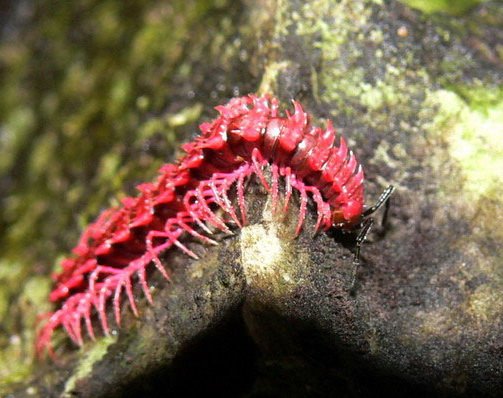

In the case of the pagona, they are quite funny. Fighting and raping in form of mating. If there was a way were this animals can recognise their older species, it would have been nice. So there will be respect according to age. That's why humans are quite different from animals. Though science says that humans are higher animals. Nice combination. Much explanatory. Welldone
Thank you @wisdomdavid. Glad you like it.
Hi @chloroform!
Your post was upvoted by utopian.io in cooperation with steemstem - supporting knowledge, innovation and technological advancement on the Steem Blockchain.
Contribute to Open Source with utopian.io
Learn how to contribute on our website and join the new open source economy.
Want to chat? Join the Utopian Community on Discord https://discord.gg/h52nFrV
Really strange revelations. I never get to know any of these creatures except komodo dragon which I have the honour of writing on some months ago.
Very rich piece.
Regards
@eurogee of @euronation and @steemstem communities
Thanks, @eurogee. I think that's because Komodo dragon is such an interesting animal.
I had no idea about the millipedes, pretty cool.
Boo! I want my money back.
Hahaha. Let me transfer 0.001 SBD as compensation. :P
While fighting with my cat:))
@cats @animals